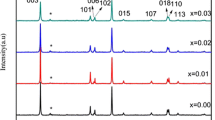Abstract
The structural and electrochemical performance of Cu-doped, Li[Ni1/3−xCo1/3 Mn1/3Cux]O2 (x = 0–0.1) cathode materials obtained by means of the sol-–gel method are discussed; we used critic acid as gels and spent mixed batteries as the raw materials. The effects of the sintering time, sintering temperature, and Cu doping ratio on the phase structure, morphology, and element composition and the behavior in a galvanostatical charge/discharge test have been systemically studied. The results show that the Cu-doped material exhibits better galvanostatic charge/discharge cycling performance. At 0.2 C, its original discharge specific capacity is 180.4 mAh g−1 and its Coulomb efficiency is 90.3%. The Cu-doped material demonstrate an outstanding specific capacity at 0.2 C, 0.5 C, and 2.0 C. In comparison with the original capacities of 178 mAh g−1, 159.5 mAh g−1, and 119.4 mAh g−1, the discharge capacity after 50 cycles is 160.8 mAh g−1, 143.4 mAh g−1, and 90.1 mAh g−1, respectively. This obvious improvement relative to bare Li[Ni1/3Co1/3Mn1/3]O2 cathode materials arises from an enlarged Li layer spacing and a reduced degree of cation mixing. Therefore, Cu-doped cathode materials have obvious advantages in the field of lithium-ion batteries and their applications.
Similar content being viewed by others
Change history
09 July 2019
In the original article, Fengzhang Ren���s and Jingjing Ma���s first names are spelled wrong. They are correct as shown here.
09 July 2019
In the original article, Fengzhang Ren���s and Jingjing Ma���s first names are spelled wrong. They are correct as shown here.
09 July 2019
In the original article, Fengzhang Ren���s and Jingjing Ma���s first names are spelled wrong. They are correct as shown here.
09 July 2019
In the original article, Fengzhang Ren���s and Jingjing Ma���s first names are spelled wrong. They are correct as shown here.
References
N. Javad and F. Yosef, Environ. Prog. Sustain. (2017). https://doi.org/10.1002/ep.12535.
D.R. Cooper and T.G. Gutowski, J. Ind. Ecol. 21, 38 (2017).
L. Joungphil and J.P. Moon, Adv. Energy Mater. 7, 1602279 (2017).
Y.R. Wang and H.S. Zhou, Energy Environ. Sci. 9, 2267 (2016).
C. Avila, K. Cedano, and M. Martinez, Int. J. Environ. Sustain. 13, 1 (2017).
H.R. Yao, Y. You, Y.X. Yin, L.J. Wan, and Y.G. Guo, Phys. Chem. Chem. Phys. 18, 9326 (2016).
R.I. Eglitis and G. Borstel, Phys. Status Solidi A 202, R13 (2005).
R.I. Eglitis, Phys. Scr. 90, 094012 (2015).
B.C. Ong, S.K. Kamarudin, and S. Basri, Int. J. Hydrogen Energy 42, 10142 (2017).
P. Grzegorz, A. Marongiu, J. Drillkens, P. Sinhuber, and D.U. Sauer, J. Power Sources 7, 365 (2015).
E.E. Fergab, D.G. Billingcd, and A.M. Venteref, Solid State Sci. 64, 13 (2017).
F. Schipper, E.M. Erickson, C. Erk, J.Y. Shin, F.F. Chesneau, and D. Aurbach, J. Electrochem. Soc. 164, A6220 (2017).
M. Sean, B. Arman, and W. David, J. Appl. Electrochem. 47, 167 (2017).
G.E. Blomgren, J. Electrochem. Soc. 164, A5019 (2017).
T. Horita and J. Shimazaki, Electr. Eng. Jpn. 98, 68 (2017).
W.H. Zhang and K.P. Wang, Adv. Mater. Res. 1056, 3 (2014).
A. Mauger and C. Julien, Ionics 20, 751 (2014).
M.Y. Maximov, A.A. Popovich, and A.M. Rumyantsev, Adv. Mater. Res. 1120–1121, 730 (2015).
P.J. Kumar, K.J. Babu, and O.M. Hussain, Mater. Chem. Phys. 143, 536 (2014).
W. Wu and F.M. Jiang, Chin. Sci. Bull. 58, 4692 (2013).
L. Riekehr, J.L. Liu, B. Schwarz, F. Sigel, I. Kerkamm, Y.Y. Xia, and H. Ehrenberg, J. Power Sources 325, 391 (2016).
S. Liu, L. Xiong, and C. He, J. Power Sources 261, 285 (2016).
J.Q. Gong, Q.S. Wang, and J.H. Sun, Thermochim. Acta 655, 176 (2017).
Z.D. Huang, X.M. Liu, S.W. Oh, B. Zhang, P.C. Ma, and J.K. Kim, J. Mater. Chem. 21, 10777 (2011).
L. Yang and G.X. Xi, J. Electron. Mater. 45, 301 (2016).
L. Yang, G.X. Xi, and Y.B. Xi, Ceram. Int. 41, 11498 (2015).
Y. Koyama, N. Yabuuchi, I. Tanaka, H. Adachi, and T. Ohzuku, J. Electrochem. Soc. 151, A1545 (2004).
L. Yao, H. Yao, G. Xi, and Y. Feng, RSC Adv. 6, 17947 (2016).
W.B. Hua, J.B. Zhang, Z. Zheng, W.Y. Liu, X.H. Peng, X.D. Guo, B.H. Zhong, Y.J. Wang, and X.L. Wang, Dalton Trans. 43, 14824 (2014).
N. Murali, S.J. Margarette, and V. Veeraiah, Results Phys. 7, 1379 (2017).
Acknowledgements
The authors are grateful for financial support obtained from the Natural Science Foundation of China (Grant No. 51304064) and (Grant No. 51502318), China postdoctoral Science Foundation (2017M622341), 2016 high-level talent research project of Henan Institute of Science and Technology (304010617001), Henan postdoctoral science foundation and funding (103020217004/001) for postdoctoral research projects of Henan Institute of Science and Technology. The authors thanked Zhaopei Zhang and Xinsheng Wang for their contribution in the process of sample detection.
Author information
Authors and Affiliations
Corresponding author
Rights and permissions
About this article
Cite this article
Yang, L., Ren, F., Feng, Q. et al. Effect of Cu Doping on the Structural and Electrochemical Performance of LiNi1/3Co1/3Mn1/3O2 Cathode Materials. J. Electron. Mater. 47, 3996–4002 (2018). https://doi.org/10.1007/s11664-018-6284-8
Received:
Accepted:
Published:
Issue Date:
DOI: https://doi.org/10.1007/s11664-018-6284-8




